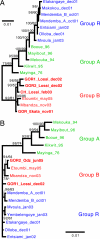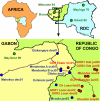Isolates of Zaire ebolavirus from wild apes reveal genetic lineage and recombinants
- PMID: 17942693
- PMCID: PMC2040453
- DOI: 10.1073/pnas.0704076104
Isolates of Zaire ebolavirus from wild apes reveal genetic lineage and recombinants
Erratum in
- Proc Natl Acad Sci U S A. 2007 Dec 4;104(49):19656
Abstract
Over the last 30 years, Zaire ebolavirus (ZEBOV), a virus highly pathogenic for humans and wild apes, has emerged repeatedly in Central Africa. Thus far, only a few virus isolates have been characterized genetically, all belonging to a single genetic lineage and originating exclusively from infected human patients. Here, we describe the first ZEBOV sequences isolated from great ape carcasses in the Gabon/Congo region that belong to a previously unrecognized genetic lineage. According to our estimates, this lineage, which we also encountered in the two most recent human outbreaks in the Republic of the Congo in 2003 and 2005, diverged from the previously known viruses around the time of the first documented human outbreak in 1976. These results suggest that virus spillover from the reservoir has occurred more than once, as predicted by the multiple emergence hypothesis. However, the young age of both ZEBOV lineages and the spatial and temporal sequence of outbreaks remain at odds with the idea that the virus simply emerged from a long-established and widespread reservoir population. Based on data from two ZEBOV genes, we also demonstrate, within the family Filoviridae, recombination between the two lineages. According to our estimates, this event took place between 1996 and 2001 and gave rise to a group of recombinant viruses that were responsible for a series of outbreaks in 2001-2003. The potential for recombination adds an additional level of complexity to unraveling and potentially controlling the emergence of ZEBOV in humans and wildlife species.
Conflict of interest statement
The authors declare no conflict of interest.
Figures



References
-
- Pourrut X, Kumulungui B, Wittmann T, Moussavou G, Délicat A, Yaba P, Nkoghé D, Gonzalez JP, Leroy EM. Microbes Infect. 2005;7:1005–1014. - PubMed
-
- Lahm SA, Kombila M, Swanepoel R, Barnes RF. Trans R Soc Trop Med Hyg. 2007;101:64–78. - PubMed
-
- Leroy EM, Rouquet P, Formenty P, Souquière S, Kilbourne A, Froment J-M, Bermejo M, Smit S, Karesh W, Swanepeol R, et al. Science. 2004;303:387–390. - PubMed
-
- Leroy EM, Telfer P, Kumulungui B, Yaba P, Rouquet P, Roques P, Gonzalez JP, Ksiazek TG, Rollin PE, Nerrienet E. J Infect Dis. 2004;190:1895–1899. - PubMed
Publication types
MeSH terms
Associated data
- Actions
- Actions
- Actions
- Actions
- Actions
- Actions
- Actions
- Actions
- Actions
- Actions
- Actions
- Actions
- Actions
- Actions
- Actions
- Actions
- Actions
- Actions
- Actions
- Actions
- Actions
LinkOut - more resources
Full Text Sources
Medical
Molecular Biology Databases
Research Materials
Miscellaneous

